Toshiba Satellite L645D: Mobile AMD at 3GHz
by Dustin Sklavos on March 9, 2011 3:20 AM ESTAMD's Fastest Mobile Dual-Core
Okay, so that's not technically accurate: as of this writing there's a 45-watt Phenom II X620 BE running at 3.1GHz, but I challenge our readership to find a notebook employing that chip. That leaves us with the L645D enjoying the mobile equivalent of an Athlon II X2 250, a $60 desktop chip that still offers enough horsepower to do general computing fairly comfortably. Remember that AMD is the reigning budget champion on the desktop. So that said, can a 3GHz AMD chip close the gap with Intel's hardware?

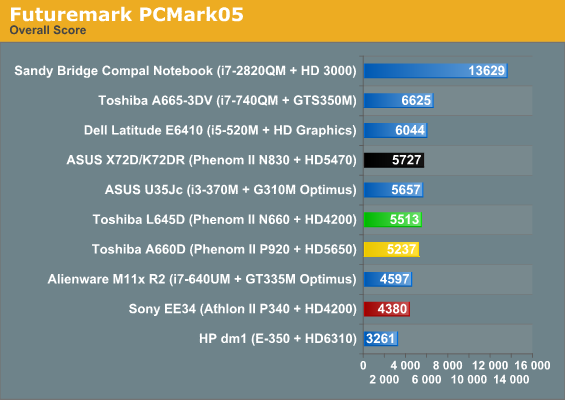
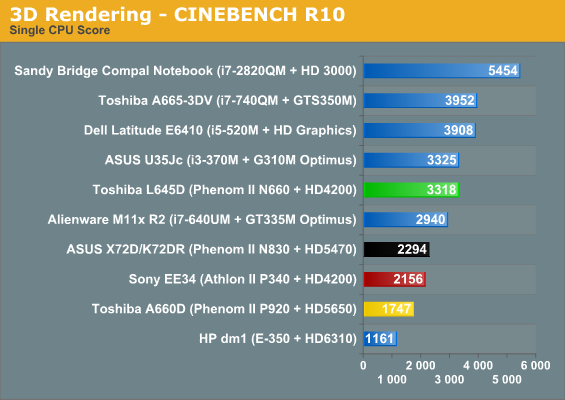
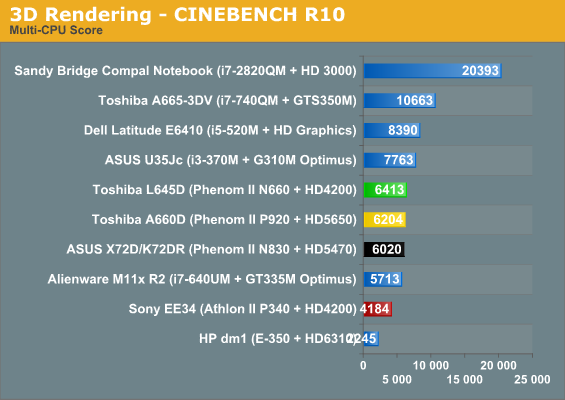

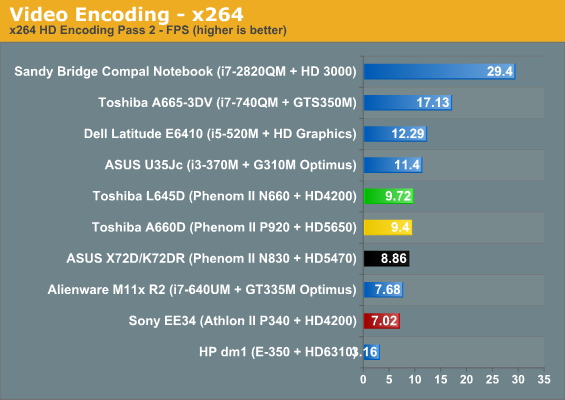
The two main take-aways here are that at 3GHz, AMD can at least hang with the i3-370M for the most part, and that AMD's mobile tri-core and quad-core chips were probably ill-advised. The extra headroom afforded by only having two cores allows the N660's 3GHz core clock to meet or beat the P920 with its four 1.6GHz cores and the N830 with its three 2.1GHz cores in even heavily threaded workloads. Ultimately the N660 is going to seem a little slow by comparison, but it's still offering a healthy amount of performance for most tasks and I wouldn't be completely aggravated doing more processor-intensive work (like video editing) on it.
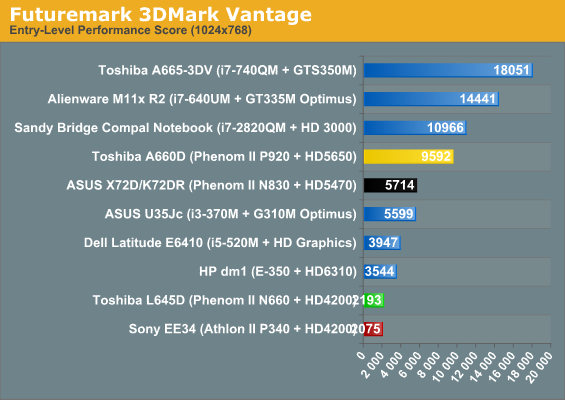
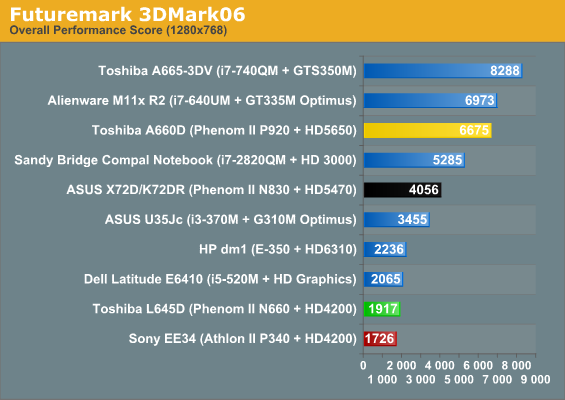
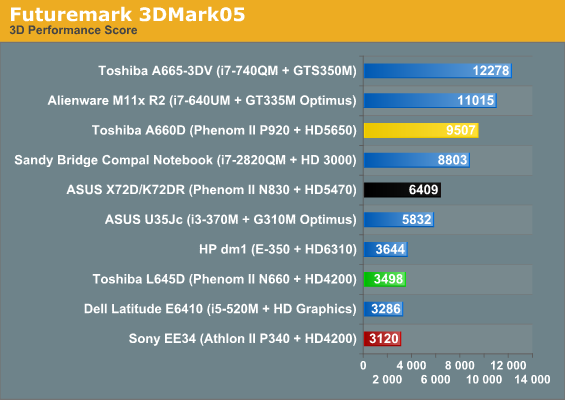
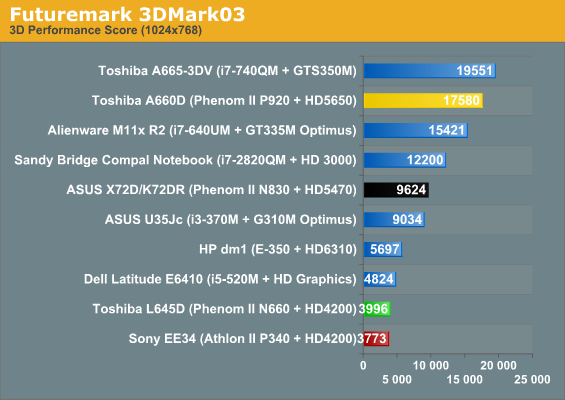
Unfortunately, though the extra 800MHz on the processor gives the L645D a leg up on Sony's EE34, the HD 4200/4250 starts to show its age again. Intel's HD graphics in the Dell Latitude post numbers on par with it in most disciplines (beating it soundly in 3DMark Vantage), but when we get to actual game testing we'll find that to be less the case.
This is where it would be good to point out that Toshiba loses one of the main points of leverage AMD's integrated graphics have over Intel's solutions: driver quality. As Jarred has mentioned in the past (and it does bear repeating), Toshiba has inexplicably opted out of AMD's mobile driver program, leaving you at their mercy. Sony doesn't get off any lighter: they opted out, too. There's really no good reason for this (especially since downloading the actual driver on another machine and then installing it on these notebooks still works), and it actively sabotages one of the strongest aspects of AMD's graphics hardware.










61 Comments
View All Comments
Dustin Sklavos - Wednesday, March 9, 2011 - link
Glossy plastic looks good in photos and that's about all it's good for; using glossy plastic for the keyboard is insane.mmatis - Wednesday, March 9, 2011 - link
I no longer touch any Toshiba products. Your mileage may vary.Vincent - Wednesday, March 9, 2011 - link
I see 10/100 ethernet offered on a surprising number of notebooks. Why cripple a machine like this? I wish reviewers would criticize manufacturers for not offering gigabit ethernet.alent1234 - Wednesday, March 9, 2011 - link
almost everyone uses wifi these days, and this is a way to cut some costs on a low margin product. most people won't care about no gigabit since no one has gigabit broadband and the whole home media server thing is a tiny nicheanactoraaron - Wednesday, March 9, 2011 - link
yeah but let's face it, we're talking about a difference of about a dollar to Toshiba for the gigabit upgrade. And to say whole home media server or even media sharing is a niche in regards to a laptop with a blu-ray player seems a bit off base.piroroadkill - Thursday, March 10, 2011 - link
No. If you want to use the laptops in a small business situation, imaging over gigabit is much, much faster.Believe me, consumer laptops DO get used in small business/education environments.
Also, gigabit ethernet would cost almost nothing to add over 10/100. There's simply no reason not to have it.
piesquared - Wednesday, March 9, 2011 - link
I recently bought an Acer 5552G with one an N660, and it's a terrific notebook. It has a 6470M but I never bought it for the gaming, even though it has no problems for what I use it for. Highly recommend the processors, and i'd wouldn't touch one of those flakey sand bridge things, or whatever they're called. It's a big risk buying one of those unstable and flawed parts.Kibbles - Wednesday, March 9, 2011 - link
I'm curious as to why glossy plastic is so adamantly deemed as bad, as if it's fact. I myself prefer the ultrafine matte that's almost like a paper texture, but that's a personal preference. I'm sure there's lots of people out there that like glossy plastics. I know my mom likes it. Could it be that the demographics that these low end laptops target predominantly prefer glossy plastics? Has any manufacturer ever given any statistical feedback on this?LoneWolf15 - Wednesday, March 9, 2011 - link
The amount of crap loaded on Toshiba laptops disguised as useful software makes me avoid them. Hey, we have a separate widget for managing absolutely everything, and each one runs in a separate process that takes up additional RAM, and each one is a separate executable that takes up disk space too! Isn't that NEAT?Toshiba, a bit of advice: Look at apps like Dell ControlPoint, or even a few of Lenovo's (not as cohesive, but still better thought-out), and realize what a great service you could do your users by bundling nearly a dozen system utilities into a single, unified app. That way, the average user doesn't have to send a system to me to figure out what is useful, what is not, and why all of the stock software is sucking half a gig of RAM (on top of what the OS takes) out of the box, and thrashing the disk. Actually, you're also less likely to have a user say "I'll never buy a Toshiba again, they're ungodly slow."
KiwiTT - Wednesday, March 9, 2011 - link
After nearly 8 years since that model was released, I would have thought we would have had double or even triple the resolution in a 14" form-factor.And it is not just Toshiba, it is nearly all the manufacturers. And if you want comparable resolution to the T41, you have to pay almost double. While you may say that the new notebooks have better brighter Screens, CPUs, Graphic Cards, Battery life, etc., it seems as if screen resolution has been stuck in neutral. This is the main portal to all that is available in the notebook, so it should be the best it can be.
I think major review sites like this one and others should actually start bemoaning this lack of increase in resolution for more mainstream notebooks. Even the new ipad2 was rumored initially to have a better resolution, but no, this was false again.